|
Monday, April 25, 2011 Quito – Galapagos
Wake up call at 6:30 – bags by the door by 7 – then off to breakfast. We’re lucky to be traveling with such a great group who is always on time and respectful of each other.
The bus took us to the Quito Airport in time for our 10:15 departure. There is a special terminal for Galapagos departures. Sofy took care of all the details and then said good-bye to us at the gate.
Our flight stopped at Guayaquil, before continuing to the island of San Cristóbal in the Galapagos. (Pepe, our guide for the Galapagos, joined us in Guayaquil.) They actually serve food on the airplanes here – and the flight attendants are nice.
We landed in the town of Baquerizo Moreno (San Cristóbal Island), the capital of Ecuador’s Galapagos Province with a population of about 5,600. (About 23,000 people live on the Galapagos Islands). The sleepy town caters to the tourists and is also home to a naval base and a radio station. We gathered our bags and linked up with Pepe and then took a 2-minute bus ride to the dock.
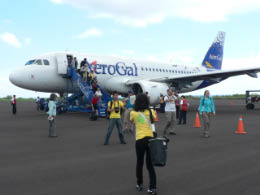
Arriving on Aero Gal |
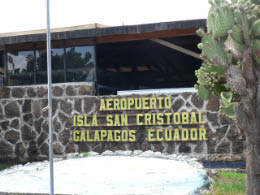
San Cristóbal Airport |
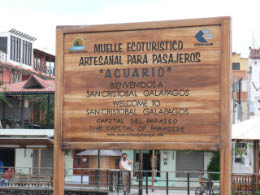
Say What? |
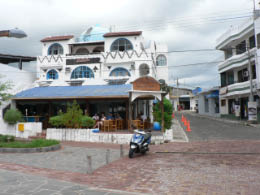
Baquerizo Moreno |
Pepe is a native of San Cristobal and claims it’s the best island in the Galapagos. To keep immigration down and to conserve the islands, only the people born in the Galapagos can live here. Also only people who live here can have the tourist-related jobs. From the bus window I spotted bars, restaurants and surf and dive operations. Pepe said the people in the island are very friendly – and Pepe is the friendliest, by far! However, the town has a problem with alcoholism because there’s not much for the locals to do. The boys play a little soccer, then head for the bars.
We arrived at the dock and found it littered with sea lions. They have taken over – even hogging the public benches. They are fascinating to us newcomers – but a nuisance to the locals. We made our way through the sea lions with their big “puppy dog eyes” and boarded the panga (dinghy – it’s actually a Zodiac). We motored to our boat – Archipel II – a 16-passenger catamaran. It was a lovely ride through old fishing boats intermingled with yachts and other tourist boats.
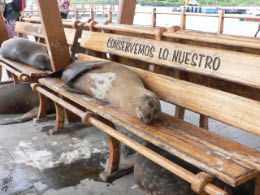
Sea Lions relaxing on the dock |
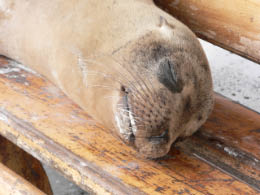
ZZZZZZZZZ |
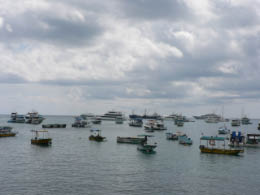
San Cristóbal Bay |
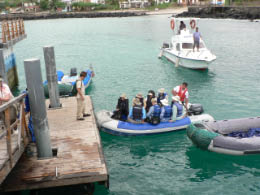
Loading the panga (zodiac) |
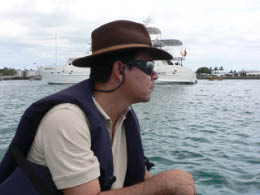
Pepe |
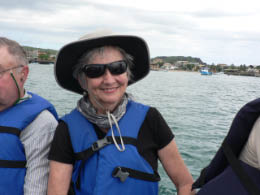
Nancy on the panga |
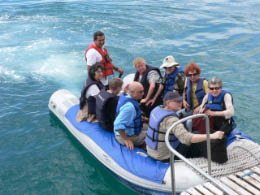
Arriving at the Archipel II |
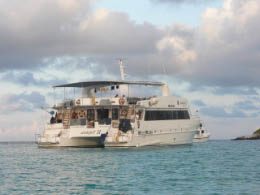
The Archipel II |
We went aboard and were all pleased with our new home for the next 7 nights. Pepe gave us an overview. He's quite the character. He’s been conducting tours for 16 years and knows his stuff. Three of our group were returning “frequent OAT passengers.” They got their first choice of the cabins. The rest of us drew for the remaining cabins. We got the “Sea Lion” cabin – to which Pepe gasped. I asked him if it was a bad room and he said, “You’ll find out.” I hope he’s just a jokester. We’ll see.
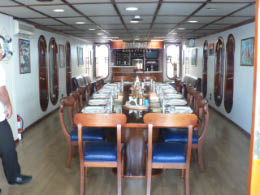
Archipel II Dining Hall |
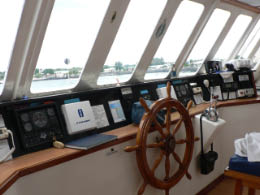
Archipel II wheelroom |
We unpacked and then had a big lunch – fish, potatoes, salad – delicious and filling. Can’t believe we wolfed the food down after the two in-flight meals we had already consumed today.
Around 2:00, we took the panga back to the town and then boarded a bus to San Cristobal’s Giant Tortoises Breeding Center. It was a mellow 45-minute drive to the highlands over red clay roads with big potholes. The clouds rolled in bringing a little rain to wash things down and cool things off. I like that fresh and green smell after a rain. We passed through a couple of little villages with the occasional stray dog. The island is definitely a “no worries” kind of place.
La Galápaguera de Cerro Colorado is a new interpretive center set up to reintroduce the giant tortoise (Geochelone elephantopus) to the south end of San Cristobal Island. The protected reserve covers 6,000 acres to breed and protect the San Cristobal Giant Tortoises. The government brought giant tortoises from the north end of the island and set up a small breeding center to bring the giant tortoises back to the place where they had once thrived.
Because the giant tortoise is one of the most devastated of all species in the Galapagos Islands, they certainly need protection. Rats, pigs, dogs, ants (of the Solenopsis variety), wild cats and other man-introduced species prey on tortoises. They raid the tortoise nest for eggs and gobble up the young. Goats and burros are also enemies of the tortoise because of the damage or destruction they do to the tortoise habitat. However, the tortoises only need protection for the first 5 years – then they are released back into “the wild.” After 5 years of age, the tortoise’s backbone fuses with the shell, making them impenetrable and no longer a desirable menu item.
Pepe led us on lava trails within the Reserve. He stopped and pointed out some plants. I remember the wild cotton, a relative of the hibiscus, and the poison apple (looks like a ficus, but causes a rash like poison ivy – STAY AWAY!). We also saw some Darwin Finches and Mockingbirds.
| We didn’t find any tortoises at the first pond. Pepe said because of the recent rain, the tortoises don’t need to visit the pond. They come to cool themselves (regulate their temperature) and rid themselves of parasites. Tortoises on other islands that do not have access to water take along their bird pals to eat their parasites.
We were thrilled when we had our first tortoise spotting—a 400 pounder. (A few tortoises have pushed 800 pounds.) |
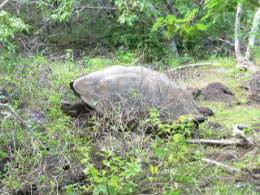
Our first tortoise spotting |
Here are some of the facts from Pepe :
- Nobody really knows how old the tortoises get. One hundred seems to be a good hunch, but others have stories about tortoises reaching 200.
- Their shell weighs only about 35 pounds.
- They have a big lung capacity.
- They must exhale the air from their lungs before they can tuck their heads inside the shell.
- The males have larger and longer tails and a concave breast plate designed for mounting.
- The males only make a noise during mating season – an unearthly groan that can be heard for miles.
- They have a very slow metabolism. They move slowly and take a long time to die.
- They hold water in their bladders. The longer it’s there, the more purified it becomes. Fishermen and others have been known to kill a tortoise for its meat and water (urine).
- Whalers, pirates, explorers, soldiers and fishermen were the first to exploit the giant tortoises as a food source. Because tortoises live a long time without food and water, they can last for about 6 months stacked on their backs -- great for storing this tender meat in a ship’s hull without the need of refrigeration – there’s no smell and not much bother.
- When the Galapagos Islands were first discovered, there were 250,000 tortoises and 14 islands had their own species. Now only about 15,000 are left and 3 of those species are near extinction – Santa Fe, Floreana and Fernanadina. The Pinta only has one surviving member – Lonesome George. (We’d see him later at the Darwin Research Center in Santa Cruz.)
- In later years, tortoises were hunted for oil as well as the meat.
Pepe swears that tortoise oil knocked cancer right out of one his relatives. Now we don’t want that word to get around, do we, Pepe?
We saw our second tortoise dug into the mud.
We visited the tortoise hatchery – much like the fish hatcheries. The baby tortoises were grouped in concrete bins with chicken wire covers, organized according to their year of birth. I was especially fond of #17, huddled in the corner from the year of 2008.
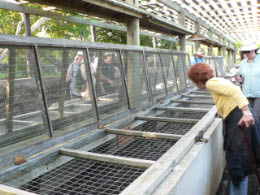
Fran checking out the tortoises |
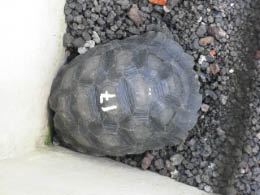
Tortoise No. 17 |
Our bus brought us back to the town (Baquerizo Moreno) just as the sun was setting. We had a few minutes to check out the place before our panga arrived to take us back to the Archipel II Catamaran.
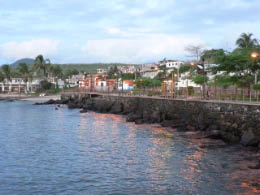
Baquerizo Moreno |
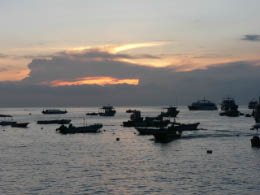
Sunset on the bay |
We were back on the ship (Catamaran) by 6. Bill and I ordered a beer from the friendly bartender, William, and went up on the sun deck to relax. The night air (with the beer) was lovely – a relief from the hot day.
At 6:30, we went down to the dining area. The captain and the 8 crew members offered us a welcome cocktail. Pepe introduced each crew member. Most are from the Galapagos (required unless no one from the Galapagos is available) and all dressed in their finest white uniforms. They looked sharp and young and strong and handsome. The cocktails turned out to be pretty potent. The captain (Paulo– or Pollo – as in Marco) joined us for dinner. He is a sweet, darling guy – quiet, serious about his work, fun loving, and well respected by his crew. We were pleased with Chef Wellington’s dinner -- veggie soup and spaghetti (and other things I don’t recall).
Bill is still a little under the weather so we retired to our room right after dinner. It’s hot and steamy and the a/c is on overload – but we’re happy to be settled in our cabin. Now if only Bill can kick this sore throat thing.
Galapagos – A Little Background (for those with inquiring minds)
Located on the equator about 600 miles west of Ecuador’s mainland, the Galapagos Archipelago is a chain of islands -- 13 large islands, 6 small islands, 42 islets and a number of small rocks and pinnacles. The islands were formed when a group of submarine volcanoes grew from the ocean floor, until they finally emerged above sea level about 3.5 million years ago – relativity new for this old world. In fact, the youngest of the islands is Fernandina and only about 300,000 years old. Newer islands are forming as I write. Each island is formed from a single volcano, with the exception of Isabela, the largest island made up of 6 volcanoes strung together. The oldest island is Isla Española in the South west, while Fernandina and Isabela in the northwest are the youngest and most volcanically active.
Like the Hawaiian Islands, the Galapagos are formed from volcanoes with dome-like gently sloping sides (known as shield volcanoes). Shield volcanoes, roughly circular or elliptical in shape, are built up by frequent eruptions of basaltic lava coming from a central vent. One big rub in the process, as the islands are growing, the plate (Nazca Plate) that holds the islands is driving under the continent. Galapagos is losing a few centimeters a year. At this rate, the Galapagos will be gone in about 50 million years – so better make those travel arrangements now.
The Galapagos Islands are very active volcanically. The islands had over 50 eruptions in the last 200 years. Fernandina has erupted on a regular basis, every 4-5 years since 1968, with the last eruption in 1995 when lava flowed into the sea. Volcan Cerro Azul on Isabella has erupted about every ten years since the 1950’s with the last eruption only a couple of years ago.
Because the islands are isolated and surrounded by several hundred miles of open ocean, the climate is determined almost exclusively by ocean current and influenced by the trade winds that push them. They are situated at a major intersection of several ocean currents:
- the cold Humboldt current (which predominantly influences the climate),
- the cold Cromwell current (which is responsible for much of the unique marine life around the Galapagos) and
- the warm Panama current.
The intensity of these currents varies during the year, as the respective trade winds that blow them. Thus two distinct seasons – dry season and wet season – that occur depending on which current is dominant at the time.
DRY SEASON (called the Garua, lasts from May to December): For most of the year the Galapagos is cooled by the Humboldt Current coming from the Antarctic. If I got this right, this cool current comes from deep below the ocean. It is blocked by the islands, causing the ocean and coastal currents to sweep upward. This creates nutrient-rich cold waters from below the surface. The cold waters rise up and cool the air above them, producing a temperature inversion. The mist rising is trapped by the volcano creating a continuous mist on the island at the higher levels. Because of the moisture in the mist, Pepe says farmers prefer the dry season for their crops. Keep in mind the Galapagos highlands are kept damp during the dry season, but the lowlands and low-lying islands remain bone dry. (And the water is chilly for snorkeling, especially without a wetsuit. My opinion -- it’s best not to come in the Dry Season.)
WET SEASON (lasts from December to May): When the Southeast trade winds slacken around December, the Humboldt current loses its driving power. The north east trade winds become dominant bringing the warm, but nutrient poor, waters of the Panama current south. The waters around the Galapagos are warmed to about 80 degrees Fahrenheit and, as a result, the inversion layer breaks-up. The tropical weather pattern takes over again. Cumulus clouds build up during the morning and a downpour occurs most afternoons, and the ocean waters are warm for good snorkeling.
The cold Cromwell current (also known as the subequatorial countercurrent) is also very important to the Galapagos Islands and is the main reason why the marine environment around the islands is so unusual. The Cromwell current is a deep flow of oceanic waters coming from the western Pacific and running beneath the Equator in the opposite direction of the westward moving surface. With a temperature of only 55 degrees Fahrenheit, the Cromwell current runs thousands of miles along the depths of the ocean gathering nutrients which rain down from the surface layers above. When the current runs into the submarine Galapagos platform, it upwells to the west of Fernandina and Isabela Islands and then dissipates towards the center of the archipelago.
El Niño -- About every four to seven years, the south east trades winds are not strong enough to sweep the Humboldt current northwards and the Panama current drastically warms the waters around the islands. This is known as El Niño, named by the Spanish, meaning ‘the child’ because it typically begins around Christmas. It does bring lots of rain and vegetation growth. However, the story is different below the sea. The warm Panama current keeps the cold Humboldt Current from bringing nutrients for plankton. Plankton is needed for animals low down in the food chain, e.g., fish and squid. Without this plankton, the food chain is broken and many larger animals such as the Galapagos fur seals, sea lions and marine birds such as Boobies, flightless cormorants and penguins starve to death as their food moves into deeper cooler waters.
Galapagos suffered the effects of a severe El Niños in 1982-83 that resulted in a high animal mortality. There were nine months of continuous rain to the Islands, very high humidity and sea surface temperatures of 86 degrees Fahrenheit. In 1997-98 the Galapagos suffered another drastic El Niño and many animals were again affected. The populations of some sea lions and boobies fell by as much as 50%. The Marine Iguanas also suffered because the abnormally warm waters stopped the growth of the algae they feed on. Many switched to other foods, but they had not evolved enough to digest it and starved to death with full bellies.
|
Tuesday, April 26, 2011 Galapagos – South Plazas (a.m.) / Santa Fe (p.m.)
Wake up bell at 6:30. I was thrilled to wake up in our little cabin on the boat and quickly threw back the curtain and snapped some pictures from my window – South Plazas was wonderful bathed in the early morning light.
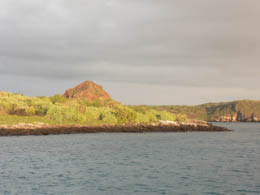
South Plaza Island |
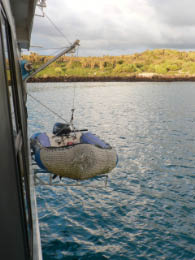
Zodiac |
We dressed, walked out our door only a few steps to the dining area. Smiling William was there to serve us a terrific breakfast. We had a variety of fresh fruit with pancakes and eggs made to order. That Chef Wellington can cook!
We put lots of sunscreen on, grabbed the essentials for our backpacks and loaded onto the panga for South Plazas. The island was formed from uplifting – not volcanic activity, although the trail is over hard volcanic rock. We did a loop trail with the most amazing sights I could ever imagine.
We disembarked from the boat (dry landing) and saw some swallow-tail gulls with their young. They let you get so close to them that you can clearly see the red rings around their eyes.
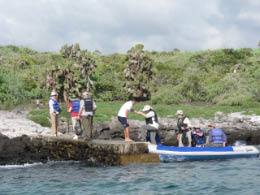
Dry landing |
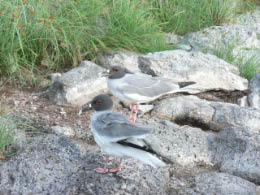
Swallow-tail gull |
Iguanas were everywhere. There are two types of iguanas – land iguanas and marine iguanas. We saw more land iguanas on our visit today. A few scattered marine iguanas were by the shore, as one might expect.
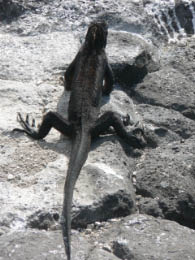
Marine Iguana |
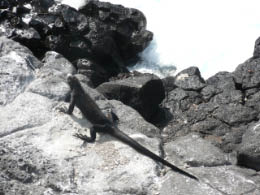
Marine Iguana |
The only true marine lizard in the world is the marine iguana. They evolved from a land species and took to the water to feed on coastal seaweed. They feed for about an hour every day at low tide. Then they come ashore to bask in the sun to generate heat in order to digest their food. Since they are cold blooded, they must regulate their body temperature. They head to the water to cool off when the lava gets too hot and they huddle together to stay warm in the morning and the evening when the day is cooler. They look sweet and affectionate in a huddled mass, but they are only trying to keep warm and are not looking for love.
Marine iguanas have a flattened tail, the better to swim with in the ocean. They have long claws to hang onto the rocks in the water. They can stay underwater for more than an hour by cutting their heart rate in half. Darwin did some studies on these guys by throwing them into the water with rocks tied to their bodies to see how long they could survive under the water. In general, Darwin was annoyed with iguanas because they covered place. He could barely walk on the island without stepping on them and had to shoe them away just to put up his tent.
When the marine iguanas are on land, they sit around expelling salt water from their nostrils (or rather salt-eliminating glands). There are 200,000 to 300,000 marine iguanas in the Galapagos. Males are larger than females. They have some kind of amazing gripping apparatus on their paws that allow them to scurry straight up a brick wall – think it’s designed to work like suction cups or maybe Velcro.
The marine iguanas are mostly black and weren’t as interesting to me as their colorful cousins, the land iguanas. Male land iguanas are especially colorful. Land iguanas live in dry areas and spend the night in dugout burrows to conserve heat. They are vegetarian and even go for cactus, spines and all. They get much of their water from their food. The baby iguanas dig their way out of nests and must watch out for predators such as hawks, owls and introduced animals such as goats, pigs and cats. If they can make it through childhood, the predators aren’t interested and then they can live for more than 60 years. They become mature between 10 and 15 when the male vigorously defends his territory and fights for the right to mate.
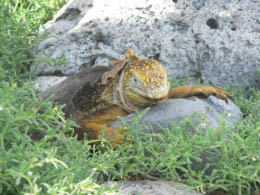
Land Iguana |
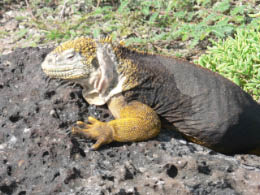
Land Iguana |
The first land iguanas we encountered were involved in a mating / dating game. The bright yellow-orange male was showing off. The female responded by running away and playing coy – all part of the game according to Pepe. Pepe said that eventually she will lift her tail and expose her genitals. The male mounts her either on the left or right side because he has 2 penises ready to go – very convenient. Pepe also told us that sometimes other males lay waiting and watching and stimulating themselves on the ground (you know what I mean). Once the female genitals are exposed, they will be ready at any time to run over and finish the job without having to put any effort into the mating ritual. The Lover Boy who bothered with all that foreplay is really mad and will try to kill the intruder rapist. The animal kingdom can be really wild.
| I came dreading the iguanas. I think it’s because they look like Godzilla. The last time we were in a place littered with iguanas was back in the late 70’s when we were crawling around the Mayan ruins in the Yucatan peninsula. I was frightened by their reptilian ways – but these guys were cute and charming and completely harmless. One of the iguanas wanted to walk along with Frank just like his pet. Gail also found a companion. It was so fun to observe the iguanas up close and personal. One was scratching her head, rubbing it against the ground, much like a cat would do. We also saw iguanas in |
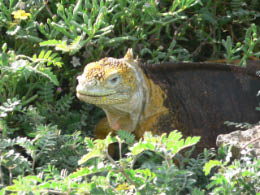
Land iguana |
trees, feasting on the leaves, looking like adorable koalas. (According to Pepe, a land iguana in a tree is very unusual. I guess they are evolving into tree iguanas.)
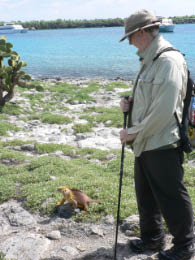
Frank and his pet |
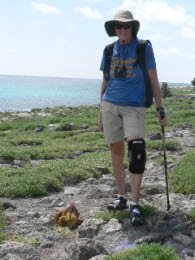
Gail and friend |
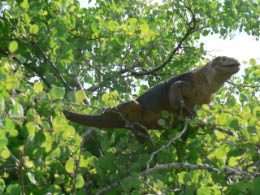
Tree Iguana |
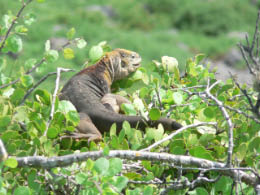
Tree Iguana |
The Galapagos is a rare and unique place because the birds and animals don’t run and hide when you show up. A lot of animals seem to welcome your presence, but at times I’m sure you’re just an annoyance to them – but never a predator.
They are able to thrive on the islands because they have no predators (except for an occasional attack from the owls or hawks on the young). They have no diseases and they have plenty to eat. The island today was very lush. The land iguanas get their water from the cactus trees. I watched one iguana munching on a cactus plant. I was surprised to see how much water was packed in the plant.
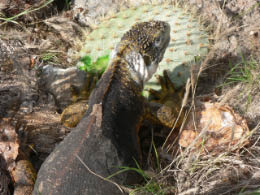
Iguana eating a cactus |
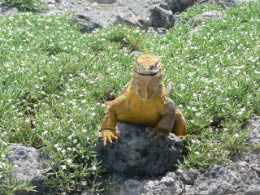
Here's looking at you, kid |
We walked past iguana after iguana on our way to the cliff overlooking the water. It was a beautiful sight. We saw all sorts of birds flying about or nesting in the rocky cliffs. There were swallow-tail gulls with their young, yellow warblers, pelicans, frigates, blue footed boobies and the only place where we saw red billed tropical birds (with a long white tails). The boobies stole my heart immediately. They were adorable with their big blue clown feet. The Spanish called them Bobo – meaning clown in Spanish – hence came the name Boobies.
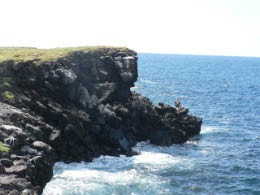
South Plaza bluffs |
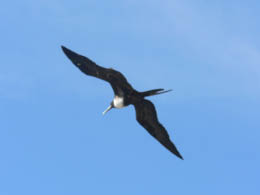
Frigatebird |
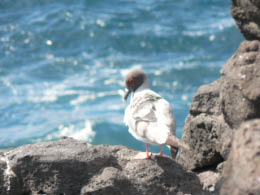
Swallow-tail gull |
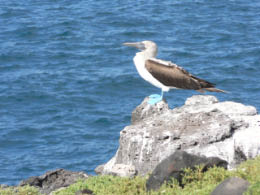
Blue footed boobie |
| One area of the cliff was reserved for a bachelor sea lion colony. The sea lions here are losers and have come to recover from battles with other males. Some survive to go back to fight again for the right to mate and some just come to die. There were only about 3 or 4 guys here today, lying around and licking their wounds.
There were about 3 groups of tourists exploring the island. The park controls the number and schedule of each boat. They do a great job of keeping the crowds down. About 300 people visit the park every day and yet you only see about 2 or 3 boats full of people. 16 is the maximum size of any given hiking group. |
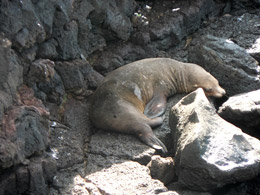
Bachelor sea lion |
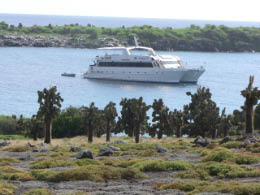
Archipel II waiting for us |
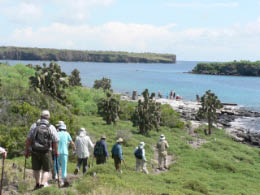
Heading toward the panga |
We circled back over the lava trail and down to the neighborhood of sea lions. I saw a couple of Lava lizards on the way – but didn’t get any good photos. The iguanas are better looking models than the wimpy little lava lizard. I did see them do some “push ups” either to regulate their body temperature or to defend their territory.
Closer to the shore, the lava rocks were polished like marble – all slick and shining. Pepe said it’s because the sea lions roll in their feces (mixed with other animals’ feces) and quite by accident, polish the rocks. (Wonder if we can bottle that stuff?)
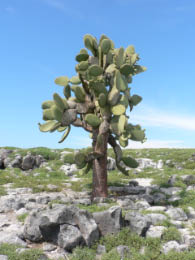
Cactus |
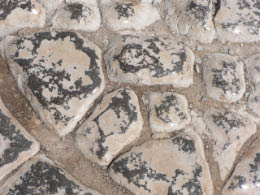
Lava rocks |
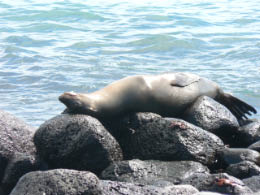
Sea lion |
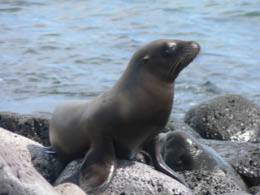
Sea lion |
Filled with wonder and delight, we finished our hike and boarded the panga to return to our boat. Back at our cabin I immediately downloaded my photos and was amazed all over again.
David got seasick and missed lunch. We were all sad for our fallen warrior – although the rest of us enjoyed our lunch of ham and a couple of salads.
After lunch we had a little siesta and then went out to do a deep water snorkel at Santa Fe Island. I dreaded the snorkeling because I hadn’t snorkeled in years and am unsure of what is lurking behind and beneath me in those waters. However, I wasn’t about to miss a thing. I made myself jump out of the panga first so I wouldn’t be a baby. The water was nice and I was ready to figure out how to get my mask adjusted.
We snorkeled for about an hour and oh the things we saw – sea turtles, a couple of golden rays, a spotted eagle ray, sting ray, a big school of yellowtail surgeons and the occasional eye-popping fish. I even saw what I thought was a sea snake – but Pepe said it was a garden snake eel. We were all giddy with the scenes from our underwater adventure. Along the sides of the rocks were more sea lions and birds.
When we got back to the main boat William served us each a cup of lovely hot chocolate along with cookies. He spoils us rotten.
We had 45 minutes to wash off and get ready for our afternoon hike. In my rush, I accidently knocked my swim suit into the toilet – YUCK!
We boarded the panga at 3:00 for the next adventure – a hike on Santa Fe Island over rocky terrain. We had a dinghy tour on the way to the landing site. We sighted blue footed boobies, brown pelicans, a Galapagos hawk, and the Galapagos mockingbird.
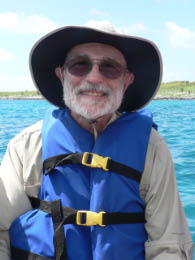
Bill in panga |
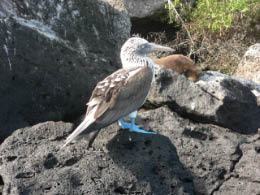
Blue footed boobie |
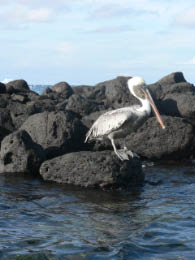
Brown Pelican |
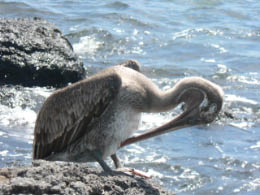
Brown Pelican |
We had a wet landing at a beautiful white sandy beach. We were greeted by a huge colony of sea lions hanging out at the beach, many of them curled up together. It was the only island where we saw such a big colony of sea lions. There was the occasional head butting, necking stretching, babies calling for their mommies (a bleating sound), and lots of belching, deep belching. It was delightful. Pepe told us that there were two males guarding this particular group. These bulls defend their beach harems by patrolling just offshore.
There are 50,000 sea lions that call Galapagos home. They snooze a lot after long, deep dives for fish. The have strong side fins for swimming and a pointed tail for running on shore – and they can go fast when they want to. Pepe said if the mother is killed or lost from the group, the other mothers will not take care of her babies. It’s a dog-eat-dog sea lion world and orphaned babies don’t make it.
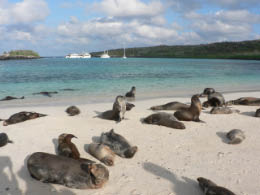
Sea lions on Santa Fe Island |
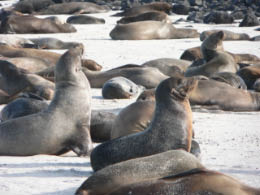
Sea lions on Santa Fe Island |
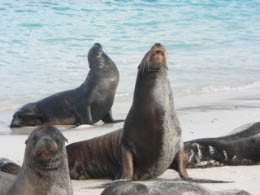
Sea lions on Santa Fe Island |
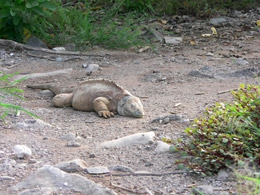
Iguana on Santa Fe Island |
We walked past the sea lions, being careful not to come between a mom and her pup or make a bull think we were picking out one of his mates. Although they seem like a gentle group, sea lion attacks are the most common cause of animal injury on the island. The trail was rocky with boulders. We found a Santa Fe land iguana (a unique species and restricted to this island).
Pepe pointed out the giant prickly pear cactus that is the food source for the iguanas. We also saw an incense tree, yellow cordea, sticky plant (that sticks to you), a goat head plant and Galapagos lantana. (As you have probably noticed, I’m much more interested in the birds and animals than the plants.)
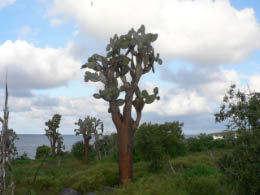
Giant prickly pear cactus |
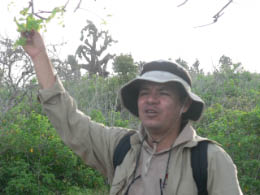
Pepe pointing out incense tree |
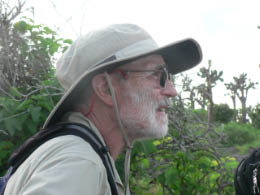
Bill listens intently |
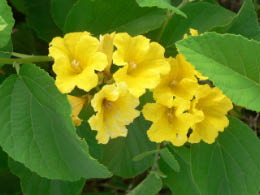
Yellow cordea
|
We got to see so many birds – especially Darwin’s finches. I’ve been reading about them for the last week (“The Beak of the Finch”) and was thrilled to see so many.
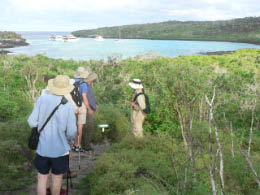
Looking for birds . . . |
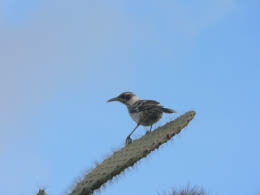
. . . found one--Galapagos Mockingbird |
We finished our loop trail back at the beach with the friendly sea lions where we had started. It was a perfect walk – the breeze was just right – the rocky lava trail was fun and oh, the views were wonderful. We took advantage of the beautiful beach backdrop and snapped pictures of each other, along with some more sea lions.

Finishing our beach walk |

Bill and Nancy |
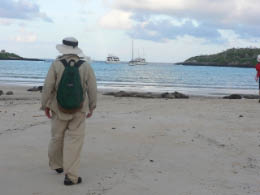
Pepe |
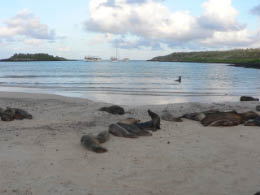
Friendly sea lions |
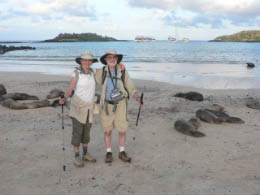
Bill and Nancy |
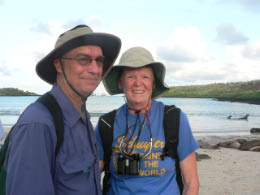
Ken and Gail |
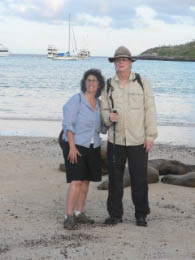
Susan and Frank |
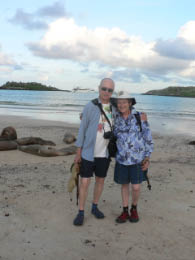
David and Lisa |
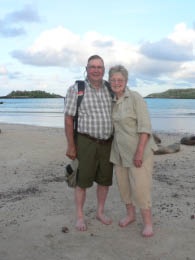
Gene and Sharon |
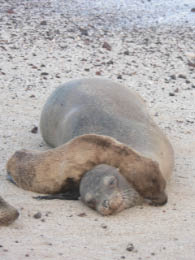
Baby and Mama |
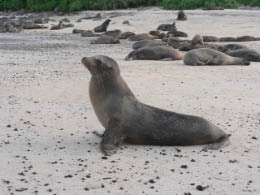
Sea lion on the beach |
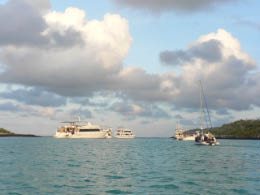
Boats waiting for us to return |
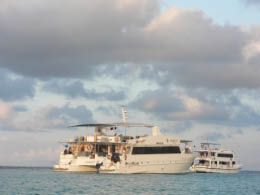
Archipel II |
We got back to the boat with hot empañadas waiting. We bought a beer from William - $2.50 - and headed up to the sundeck to enjoy the sunset and watch the frigates dive directly into the water. Lisa and David joined us.
At 6:45, Pepe gave a briefing for tomorrow’s visit to Floreana Island – I love the history of this island, but folks were tired so he cut it short.
Shrimp dinner was good. We sat next to Pepe and learned a lot.
After dinner, the captain headed the boat to the next island. The choppy open waters can be a nuisance. Better stop before I get sea sick.
Wednesday, April 27, 2011 Galapagos – Floreana (a.m.)/ La Loberia – snorkeling (p.m.)
Although I was already awake, the ship’s wake up clanging came at 6:30 -- breakfast at 7. The gang survived the heavy surf last night and all were at breakfast. After breakfast, we took a panga over to the island of Floreana (population of approximately 100). We waited on the dock to catch a chiva, a rickety old truck with seats at the back, which serves as the local transportation. We watched frigates dive bomb directly in the water in search of food. Pretty amazing sight. We also spotted some marine iguanas, crabs and the occasional sea lion.
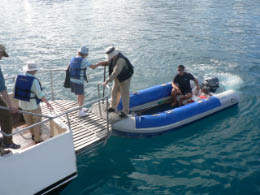
Another adventure |
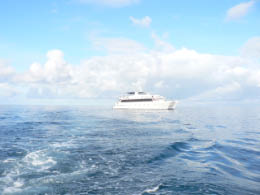
Archipel II |
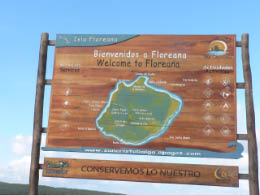
Welcome to Floreana |
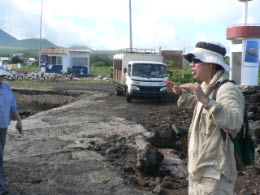
Pepe--waiting for Chiva |
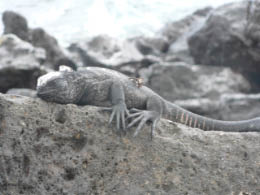
Marine Iguana |
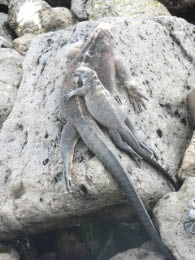
Take me for a ride |
|
At Post Office bay, just down by the bay, is the town post office. The practice of leaving the mail in a barrel (now a wooden box) began in 1793. Whalers would drop their letters into a barrel to be picked up by homeward-bound ships whose crews would hand deliver the notes, postage free. The tradition lives on – anyone can drop a card to see if someone delivers it. We drove past the post office and didn’t stop because nobody was there. |
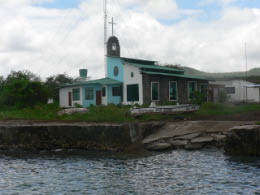
Post Office |
The bus (i.e., chiva) arrived and took us on a 30-minute ride up into the highland of Floreana. We drove through thick, lush vegetation. The open air windows on the bus kept us dodging branches that were just waiting around each corner to pop in and slap us.
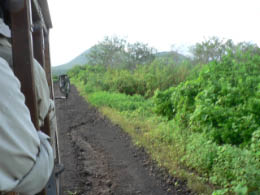
Highlands of Floreana |
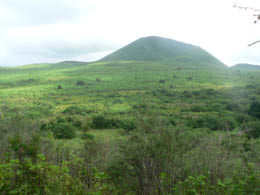
Highlands of Floreana |
We passed by the hills, Asilo de la Paz and Straw Hill, in the agricultural area of the island. Pepe explained that if a person owns land in the Galapagos, they must make an attempt to do something with it (farming, tourism, livestock); otherwise it will be taken away and given to someone else. The island grows avocados, rice, plums, tamarind, bananas and citrus fruit – think I got that right. Once in a while, we’d see a cow, a pig, or a stray dog along the road.
The tortoise reserve, near Asilo de la Paz , was built by the National Park Service to protect giant tortoises taken from the various islands. Just as we were getting off the bus, it started to rain so we put on our ponchos. According to Pepe, rain is a common occurrence here, but luck was with us and the sun broke through and we removed our rain gear.
Our first tortoise spotting was three guys in a muddy pond. Pepe gave us the clear distinction between the term “Tortoises” – live on land–and the term “Turtles” – live in the water.
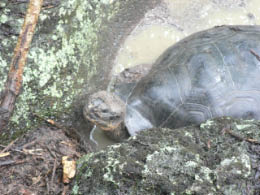
Tortoise reserve |
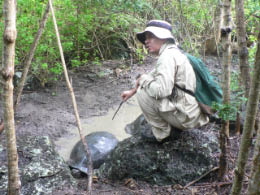
Pepe's lecture about tortoises |
We walked into a large enclosure, or corral, surrounded by a 4-foot stone structure. We found many giant tortoises littering the pathways – what a delightful surprise. We merrily went from tortoise to tortoise picking up their good vibes and documenting our adventure.
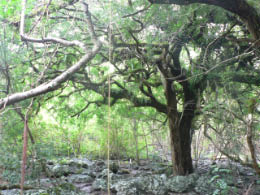
Tortoise reserve |
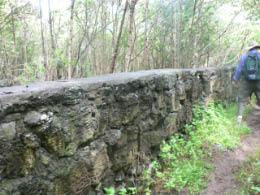
Wall separating males and females |
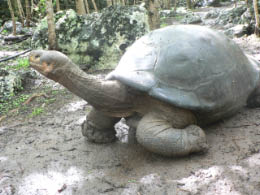
A tortoise willing to stick his neck out |
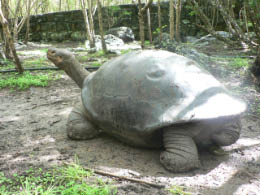
These guys are BIG |
The stone wall isolates the males from the females. The park does this to control the population and prevent an imbalance and the possibility of screwing up the gene pool. However, some of the male tortoises are clever and have learned to stack themselves up on other males so they can climb over the wall to get to the gals.
Sex is a powerful driver. Incidentally, later as we were leaving, Pepe saw a pair of tortoises trying to copulate, but the male was on the wrong end. Pepe laughed and said the female was doing this because she was playing hard to get.
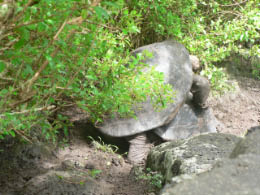
Hard to get tortoise |
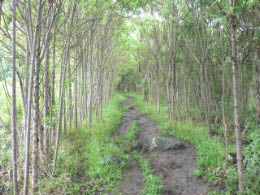
Muddy trail |
| We saw some mockingbirds, some Darwin finches and a couple of yellow warblers. The warbles were by far the cutest and really got our attention.
I don’t recall much of the plant life – it was so thick and intermingled. We did see an Angel’s trumpet. (Pepe’s mom used a stronger version of the Angel trumpet to sedate her troublesome husband.) I do recall a berry, when squeezed, serves as Elmer’s glue. Comes in handy to seal up envelopes. |
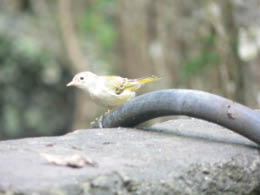
Yellow Warbler |
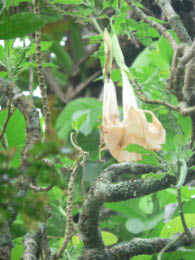
Angel’s trumpet |
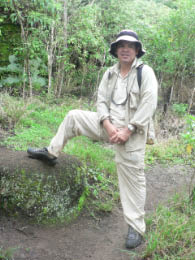
Pepe |
The main attractions of most of the Galapagos Islands are of the flora and fauna. However, on this island of Floreana, there is a lot of history.
The pirates came and hung out in caves at the base of the hill, Asilo de la Paz. The whalers and soldiers dropped in from time to time. In the 18th century there were about 80 people when it was given to an Ecuadorian military officer for his bravery in battle. He imposed slave control over the residents. They called him the Dog King and eventually forced him back to the mainland. For a while the place was a penal colony, but lacking fresh water, the colony moved to San Cristobal where there is a freshwater lagoon. A freshwater spring was found about the time the island was colonized by Ecuadorians in 1832. Later, the settlers installed a pipe to bring the fresh water to the entire population.
A lot of craziness went on in them there hills. The pirate caves became the first temporary housing (or den) for a string of folks while they built a proper place to live. Patrick Watkins, first of the settlers, occupied the caves first, then other settlers of the island followed. Most interesting of the occupants were Dr. Fredrick Ritter and his companion Dora Strauch; then came the Wittmer family.
More about Dr. Ritter and Dora Strauch (and other Island crazies who came here in the 1920’s)
Dr. Fredrick Ritter was a holistic doctor living in Germany in the early 20th century. His lover, Dora Strauch, was his patient suffering from MS. Believe me, they were both certifiably crazy. They decided to leave their spouses and families and run away to this island paradise. Dr. Ritter read the book “Galapagos: World’s End” and was convinced that this was the enchanted island where a person could live to be 140. They named their new settlement Friedo – a combination of their names. The doctor only wanted isolation and time to read. Dora wanted to do anything to make the doctor happy – even having her teeth removed along with him. He promised to make dentures – but later, they ended up getting just one pair to share between them. Lots of weirdness. When Dora became very fond of her pet donkey, the doctor became very jealous. It wasn’t long until the donkey turns up dead (with no one else on the island to blame).
After reading about the paradise and the Friedo settlement, the Wittmers (another German couple) packed up and came to the island. However, they were not welcomed by Dr. Ritter and Dora. The new neighbors were poor and had to stay in the pirates’ cave to start their own farm. They even had their baby without the help of their neighbor who happened to be a doctor. (By the way, their son was the first ever born on the island.)
The place was becoming a nudist colony and an attraction for weirdoes. Strangest of all the new inhabitants was a French self-styled baroness named Eloise Wagner de Bosquet. She brought a couple of lovers with her who were heavily into S&M. She was cruel to them, but apparently they loved it. The baroness used her sexual prowess to get anything she wanted including the deeds to all the properties on the island from the governor of Ecuador. She was outrageous. She also made plenty of enemies. She ended up “missing” with one of her S&M team members. Years later, their remains were found (and their boat) on an isolated island. |
Believe me, she was a piece of work. She enjoyed eating a dish made of flamingo tongues. Several flocks were destroyed to satisfy her taste buds. She also enjoyed bathing in the main water source for the entire island.
To spice the island up even more, Adam Hancock, a wealthy oil man from L.A. came seeking entertainment and adventure in the island and brought all the comforts from home including his own band to dance the night away, with the baroness, of course. |
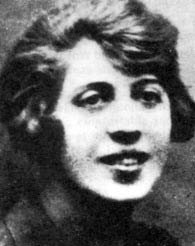 |
Later that evening, when we were back on the boat, we got to see these real characters in action on Pepe’s computer, thanks to Youtube. In the 1920’s these characters were making a movie and some of the scenes still live on. They were fabulous. The Barnoness throwing herself at one of the guys; Dora holding her hand over her mouth to hide her toothless smile. Boy, if these lava rocks could talk – my-oh-my!
Pepe took us to the natural spring and the Wittmer’s farm. We passed by the pirates caves where the German lovers took up residence when they first arrived. Later, the Wittmer family stayed in these caves while they were building their homestead. We also saw what appeared to be an ancient carving. Serious, important archeologists came to study it – but the town’s folk knew all along it was carved by Mr. Wittmer in an attempt to get their disabled son involved in an art project.
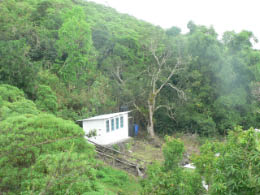
Wittmer’s farm |
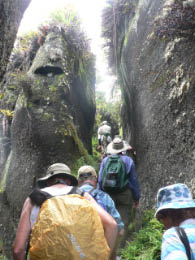
Wittmer’s farm |
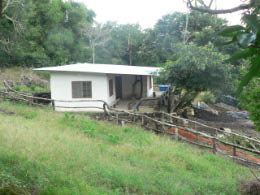
Wittmer’s farm |
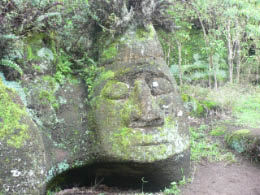
Mr. Wittmer's art project |
About 11:00, we were back at the dock, ready to board the panga for our ride back to the ship.
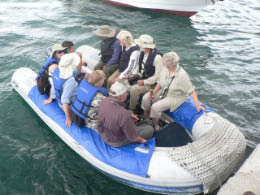
Heading back to the boat |
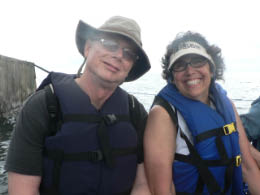
Frank and Susan |
We were greeted with drinks and munchies from William. Like Pavlov’s dog, we’re conditioned to have food and drink when we see William’s happy face greeting us at the boat. We were also surprised to see what Ronnie (A.K.A. Cabin Boy) had done with the towels on our bed. He had sculpted 2 loving swans just waiting for us. (Ronnie’s work with towels got more and more creative as the week went on.)
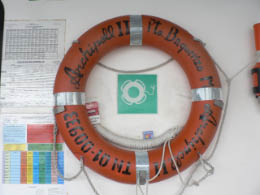
If the boat is safe why do we need these? |
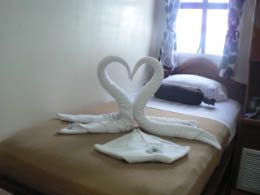
Ronnie's handiwork |
At noon we had our usual big meal starting with soup, then salad, a beef dish with peppers and French fries – which we all went nuts over.
We relaxed until about 2:00. The ship was quite. The crew members had gone somewhere to compete in a soccer game with crew members from another boat. They came roaring in the pangas just in time to transport us to our afternoon snorkel. They were dressed in their soccer uniforms and looked pumped up, so I suppose they won.
We went to one area (La Loberia) to be dropped off for snorkeling. I think there were too many boats at that harbor, so we headed to the black sandy beach for a wet landing. The waves were coming in and going out so strongly that we had a lot of laughs getting folks to shore. Our little 90-year old Fran made it – no problem.
We were spoiled by the amazing snorkeling we had yesterday – today there wasn’t much. We saw a few fish, a sea lion and a Mexican hog fish (the one with a bump on the forehead). Some saw baby black tip reef sharks and even some big sharks. (I avoid the sharks.) I was tired of splashing about so I grabbed the side of our panga parked in the ocean. The sweet panga pilot trolled me over the deep rocky areas for the best views with no effort on my part. It was magical seeing the underwater world float by. This crew is outstanding – they'll do anything for you.
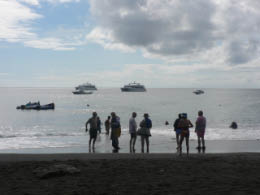
Our group ready to snorkle |
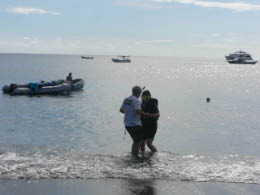
"You will go in, whether you're ready or not!" |
We got back to the boat about 4, had a beer, showered, and relaxed. We snapped a photo of our captain at the helm and a view of Floerana from our boat.
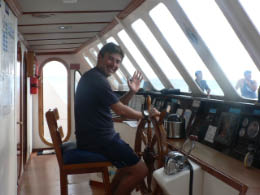
Paulo, our captain |
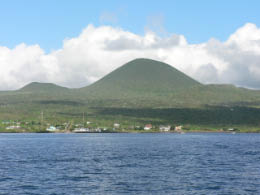
View of Floerana from our boat |
Pepe gave his briefing for tomorrow and then we had dinner – chicken, veggies, green soup (spinach) to which one added popcorn (not bad). David is back with us – but Susan is our fallen warrior tonight. She just got a little green behind the gills.
It’s 10 now – lights out – the wake up bell comes early in the morning.
Thursday, April 28, 2011 - Galapagos – Santa Cruz (Charles Darwin Research Center) (a.m.)
/ Tortoises in the wild / Coffee / Moonshine factory (p.m.)
We had a nice breakfast at 7:00 with omelets made to order.
About 8:00, we took a panga to the port of Puerto Ayora on Santa Cruz Island. Santa Cruz is the most populated island (12,000 people) and the economic center of the Galapagos. We docked in a mango grove and were greeted by lots of birds and marine iguanas. I was afraid I’d step on one of the iguanas.

Heading to Santa Cruz Islaland |
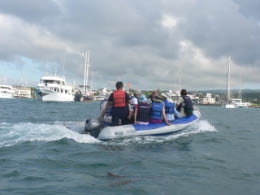
If this is Thursday, it must be Santa Cruz |
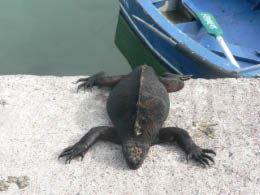
The welcoming crew |
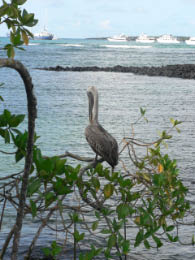
Brown pelican |
Pepe walked us to the Charles Darwin Research Center. (Get this – Charles Darwin Research Center’s main office in Belgium!) This center opened on Santa Cruz Island in 1962 to protect the endangered native species by doing research and setting up breeding programs. By that time, five tortoise races had been declared extinct, among them the Pinta Island Tortoises.
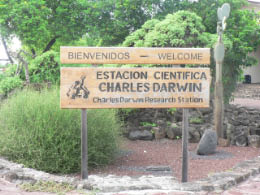
Darwin Research Center |
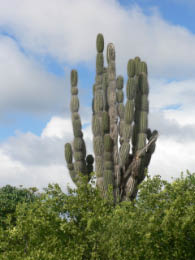
Native plant |
First stop at the Darwin center was a plant nursery loaded with native plants. Pepe said people come to learn about and use endemic drought-resistant plants on their land. The plants are here for the taking. Pepe’s mother is very involved in the program.
We entered another building with maps and charts. Pepe told us about the park’s program to remove or eradicate the predators that made their way to the islands – goats, rats, pigs, and other animals. Because they are such a threat to the native and endemic animals, the park’s philosophy is to no longer “control” these predators, but to eradicate them. The goat is now gone from Santa Cruz, thanks to GPS tracking and rifles and people willing to take them away. Pepe explained one clever way of eradicating rats. By dropping morphine pellets laced with a slow acting poison into rat’s nests, the rats go away to die so they can’t figure out where they first got poisoned.
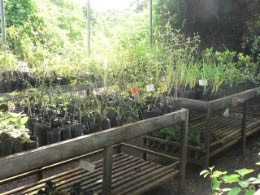
Darwin Research Center |
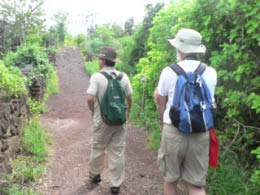
Darwin Research Center |
Eggs and hatchling tortoises are brought to the Darwin Center from natural nests in the wild from Santiago, Santa Cruz, Isabela (Cerro Azul, Sierra Negra, and Wolf volcanoes), and San Cristóbal. These populations are dwindling because of the introduced predators (pigs, dogs, goats, wild cats, etc.), and poaching by fishermen and residents who find the tortoises a nuisance.
Pepe showed us the incubator for the eggs. It’s a very simple enclosure with racks and heating devices, including a hairdryer to circulate the air. (By the way, the U.S. gave the center two sophisticated incubators. However, when they broke down, nobody could fix them, so they were trashed.)
The temperature the eggs are kept determines the sex of the tortoise. Heat produces girls while cool yields boys. The center cheats toward the hot to provide more breeders. They have done a lot to protect the tortoise. They collect eggs from the nest in the wild to bring them back for incubation. It’s vital to orient the eggs as they were in the nest in order for the embryo to attach properly. The egg-gatherer marks each egg with an “x” on the top. When the eggs are transported and placed in an incubator, the “x” always points upward. It took a lot of time and many destroyed tortoises to figure out this simple little trick.
Next we visited the baby tortoises surrounded by cages for protection. Next were larger pens for the Junior High guys. Then we found the mature tortoises together in an open area. Everyone was getting their photos taken up close and personal. One of the tortoises was tired of the gig and nipped at the pant leg of a tourist from another group. I kept my distance after witnessing that.
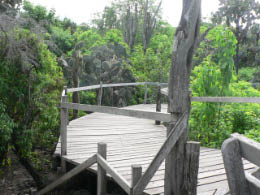
Darwin Research Center |
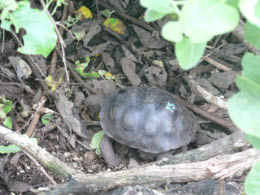
Darwin Research Center |
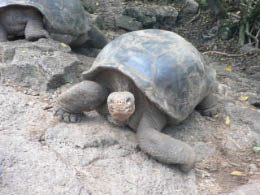
Giant Tortoise |
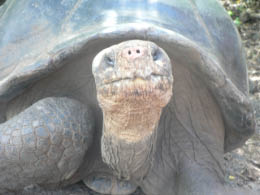
A face only a mother could love |
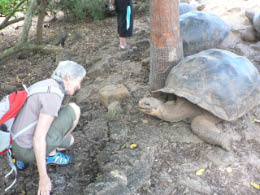
Nancy up close and personal |
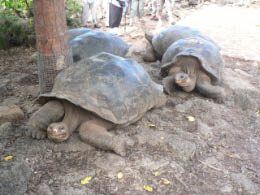
Tortiose train |
We passed through some enclosures for land iguanas. The males just wanted to get at the females.
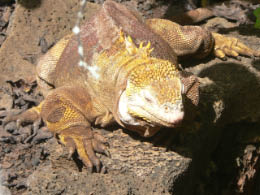
Land iguana |
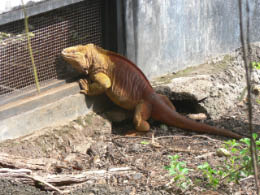
Looking for love |
The highlight of our visit to the Darwin Research Center was getting a chance to visit a couple of famous tortoise studs, Lonesome George and Dieguito (AKA Diego).
Lonesome George, a Pinta Island giant tortoise, is the rarest animal in the world today. He’s about 100 years old and when he dies, his species, the Pinta tortoises, will be extinct. We passed by his corral, but he was tucked behind the bush, so we only caught a glimpse of this famous dude’s behind. He is in a pen with two females and with the world hoping for some action. To his credit, he did manage a couple of offspring – although they are not the pure subspecies. There is a $20,000 reward for anyone who can find a female Pinto tortoise to bring the pure blood back.
According to Pepe, Lonesome George is a loser and shouldn’t be getting such press. He arrived at the center in 1971 when he was about 70 or 80 years old. They tried to mate him with other tortoises of similar type. He didn’t have a clue of what to do. The Center then hired a woman to help him get the idea of stimulating his penis. That first employee didn’t have the knack so they had to hire another woman, who had better luck. (Can you imagine what that job description looked like?)
There is another endangered tortoise species from the Island of Española that the Center is trying to save from extinction. Since 1965, two males and twelve females from Española were taken to Darwin station for breeding, but the males weren’t interested in mating. The San Diego Zoo had another one of the species – a guy named Diego. He flew to Galapagos from San Diego in 1977 and is quite the guy. Because of his efforts, there are now 2,000 of his offspring. Way to go Diego! We looked forward to getting a peek at Diego in his enclosure, but he was nowhere to be found. He was probably recovering from having too much sex or busy with his 12 girlfriends. He is responsible for bringing the population back from extinction. The story goes that he was ready to do the deed as soon as they unloaded him from the plane and put him in the female enclosure. He didn’t even have to recover from jet lag. He is Pepe’s hero. Diego just became a grandpa and is still going at it.
After our tour of the Darwin Center, we jammed into the air-conditioned gift shop to top off the visit. I bought a nice rain jacket. We had about an hour on our own to amble back through the town and to the port to catch the panga back to our catamaran. The town was quaint and quiet – no traffic or parking problems and filled with upscale shops. We found a nice shop called Cactus and got a couple of bowls made in the Amazon, painted by the hair of the artist.
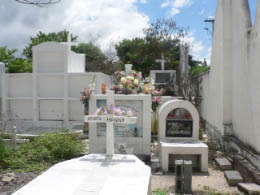
Santa Cruz Island Cemetary |
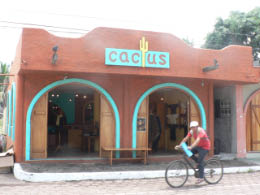
Cactus, a nice shop on Santa Cruz |
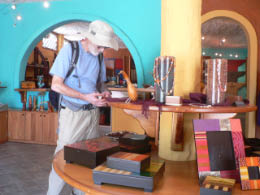
Bill pretending to shop |
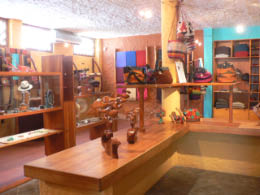
Inside Cactus Gift Shop |
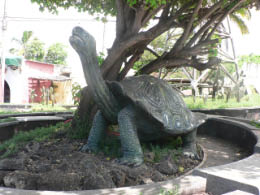
Not the real McCoy |
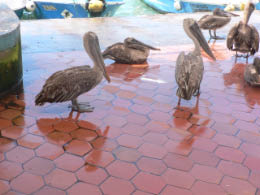
Brown pelicans in town |
It took a while to catch the panga. The waves were very high, making disembarking from the panga to the ship a bit of a challenge.
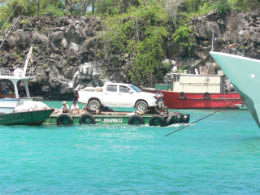
Someone's new pickup |
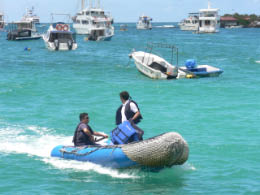
Panga coming to pick us up |
We got back to our cabins to find the towels in each room creatively folded in a clever way. Ours was a little bear wearing my sunglasses and petzel headlamp. Ronnie the cabin boy really knows how to charm you.
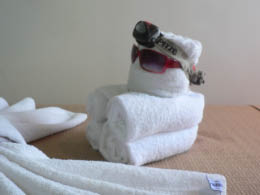
Another creation from Ronnie |
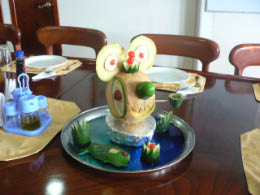
Wellington's artwork |
Lunch was especially good today – fresh albacore from this morning’s market. In San Diego, fresh albacore runs about $25 a pound.
We rested in the cabin until our afternoon adventure. I worked on the journal while Bill snoozed. He’s starting to feel better.
We boarded the pangas promptly at 2 and headed back to the main town, Puerto Ayora, on Santa Cruz. From the panga, we took a 30-minute bus ride up into the highlands to visit a private farm with giant tortoises in the wild and a lava tube. The landscape went from the dry, rocky arid to lush greenery. Raspberries grew wild along much of the road.
As we got closer to the farm, we saw the farmer / rancher herding his cattle alongside the bus. He’s sitting on a gold mine now. His establishment features a lava tube, tortoises in the wild and now some nice hotels. Pepe said many farmers (including this one) first hated the tortoises because they knocked down the fence posts allowing the cattle to escape. When this farmer realized that the tortoises always came through his property and that he could charge for the show, things changed drastically. Now folks come from everywhere and he is quite the entrepreneur.
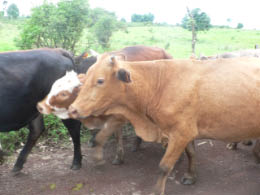
Galapagos cows |
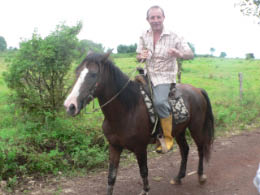
Farmer/rancher/entrepreneur |
Pepe took us down into a lava tube deep into the ground. We hung onto the rail as we descended down several wet, slippery steps into a huge tunnel-like cave. Turns out the farmer didn’t know about the lava tube until one of his cows came up missing. He discovered the cow had fallen into a hole in the ground. He rescued the cow and cleared out the undergrowth in the lava tube and now has added it to his list of attractions.
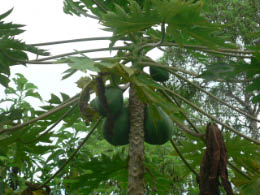
Galapagos fruit |
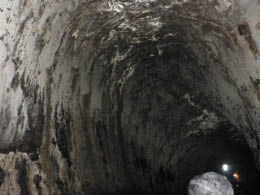
Lava Tube |
After the lava tube, we headed to the tortoises part of his business. We first had to select some rubber boots to wear through the muddy trails while we looked for tortoises. This is a private operation and does not have to control the crowds like Galapagos National Parks do.
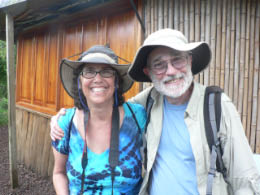
Susan and Bill |

Nancy and Frank |
The trail turned out to be a hoot. Even without the tortoises, I loved slushing in deep, gloppy mud. However, we didn’t have to look long for a tortoise to appear. They were scattered about the path. The tortoises here are called Chato tortoises – Spanish for “flat” or “flat nose.”
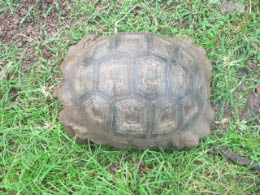
Chato tortoise |
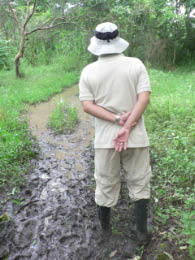
Gloppy mud |
A little way down the path, Pepe stopped and said to me, “Do you hear that sound?” He knew that moaning sound was a male in the not too far distance. The males only make that sound when they’re mating and Pepe was hot on the trail. He wasn’t about to give the lovers privacy. The moaning sounded just like a cow. Just a little way down the trail, we spotted some rocking shells behind the bushes. You could see the movements timed to the groans, but the view was not good enough for a photo.
Later we found a large tortoise parked right on the pathway, but it wouldn’t move. He did tuck his head in his shell several times. Each time he withdrew his head, he let out a deep, loud audible gasp. Pepe said he was expelling the air from his lungs to make room for his head. You just can’t believe all the marvels you see here.
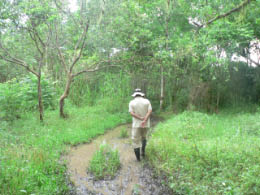
Our leader |
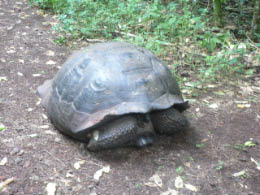
Tortoise on the pathway |
After the muddy trail of tortoises, we exchanged our muddy galoshes for our hiking boots and headed to our next activity – a coffee farm. OAT (Oversea Adventure Travel) added this to the program at the last minute. I expected the typical tour group routine where you see a little demo on making coffee and then are lead to the gift shop where you are expected to drop some bucks. This DID NOT HAPPEN.
We had a wonderful visit to the farm of Adriano and Edilia with their donkey, Angel. They are a remarkable couple and warmed the cockles of our hearts. Pepe translated as Adriano made jokes and told us about what they do – produce brown sugar, moonshine, coffee, to name a few. Adriano was full of spunk and laughter and nobody laughed harder than his wife Edilia.
Adriano and Edilia came to Santa Cruz from the mainland 42 years ago looking for work. Adriano worked on this very farm for a couple of years. Then the owner left, selling the place to Adriano. |
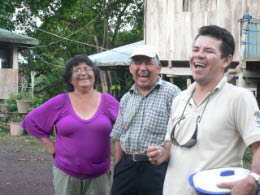
Edilia, Adriano and Pepe |
Adriano and Edilia built several thriving businesses in the Galapagos and are well respected (and, by the way, were expecting a grandchild on that very day).
| They grow sugar cane and make “moonshine.” It’s legal in Santa Cruz. In fact, politicians come from all around to buy Adriano’s 25 proof alcohol. (Apparently it’s common in the Galapagos for political candidates to serve drinks to the crowds in order to keep them interested.) Adriano demonstrated the moonshine process using his old equipment barely hanging together. To show the high octane power of his brew, Adriano threw some of his moonshine into the fire and the flames shot up. He then gave each of us a shot glass full. That stuff burned all the way down – but it was a nice burn. |
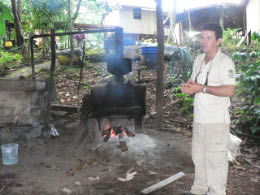
Pepe and the still |
| Then we watched as they showed us how Angel, the pet donkey, pressed the sugar cane into liquid. Adriano and Edilia were a wonderful comedy team. For all her hard work, Angel got to drink the bucket of sugar juice.
Next Adrian showed us how he made organic coffee – handpicking only the ripe beans, shelling them and then roasting them all by hand. The hotels and the locals come to buy his coffee (so did we). |
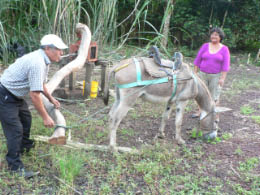
Adriano, Angel and Edilia |
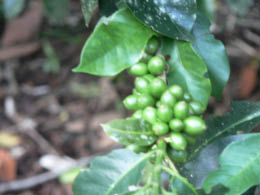
Coffee beans |
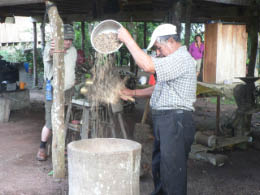
Shelling coffee beans |
Finally, as if the shot of moonshine wasn’t enough for us, Adriano and Edilia took us to their main area and served us a special mixed drink called the Submarine, because after you drink it, you hit deck or fall down.

Nancy, Bill drinking moonshine |

Nancy, Edilia,Adriano and Bill |
| To end the evening at the farm, Adriano showed us a skull of a wild boar and the scars the bore inflicted on his body just a year and a half ago. One evening, Adriano was out with his dogs to get this boar. During the duel, Adriano’s machete got stuck in the bore’s skull. It didn’t kill the bore, but it really pissed him off. The dogs joined in the battle. Adriano was lucky to get out of that one alive. He said it cost him $1600 (and a trip to the mainland) to get his body repaired. |
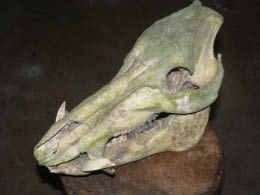
Skull of boar that Adriano killed |
Those guys are tough and amazing. We all enjoyed the laughter and the stories how they survived in this rugged paradise and raised a family of three with hard work and ingenuity. We thank Pepe for arranging this special trip. It really touched our hearts.
We took the bus back to the panga and didn’t get back on the ship until 6:30 – just time for a beer on the sunroof before dinner.
We had another nice dinner – turkey breasts with veggies and salad galore.
Only one minor incident. Poor Bill was taking a shower. He got wet, turned the water off to lather up really good, then when he turned the water back on to rinse off, there was no water to be had. I tracked down some crew members and in no time, the water was back. (Turns out they were switching the water tanks at a critical moment.)
We’re expecting choppy seas tonight – think I’ll take a drug and call it a night.
P.S. Zion (our granddaughter) is on her 4th grade overnight trip to Sacramento. She was very excited and a little apprehensive about her first trip without her parents. I wore the t-shirt she picked out for my Christmas present and thought about her on her big adventure today. Wherever you are Sweetheart, know that your NiNi and Papa love you very much.
|











